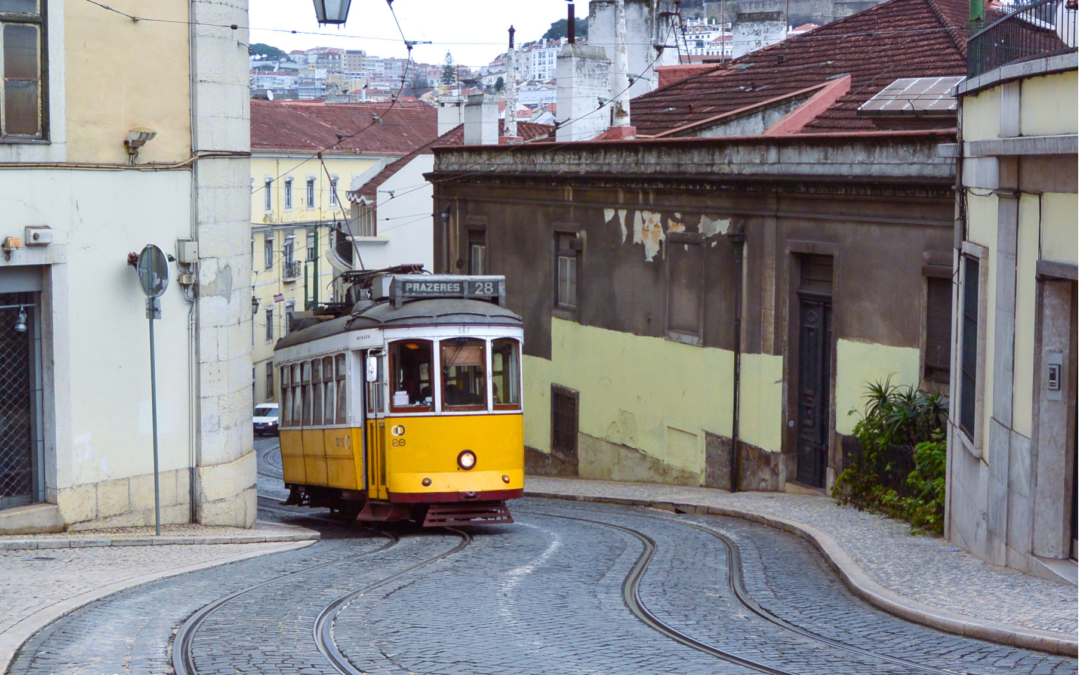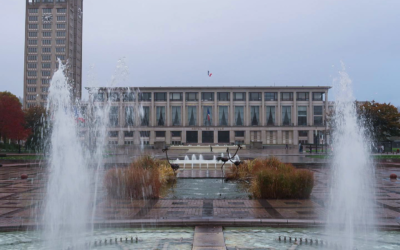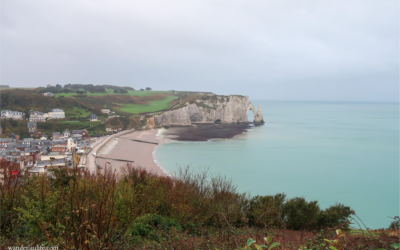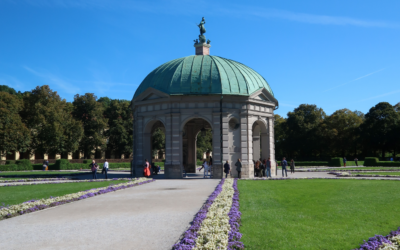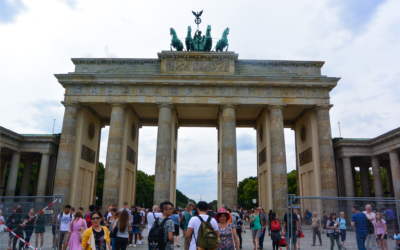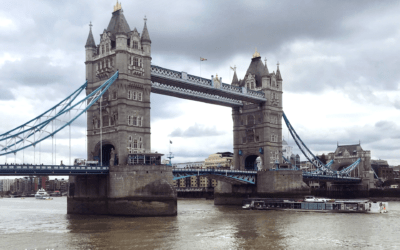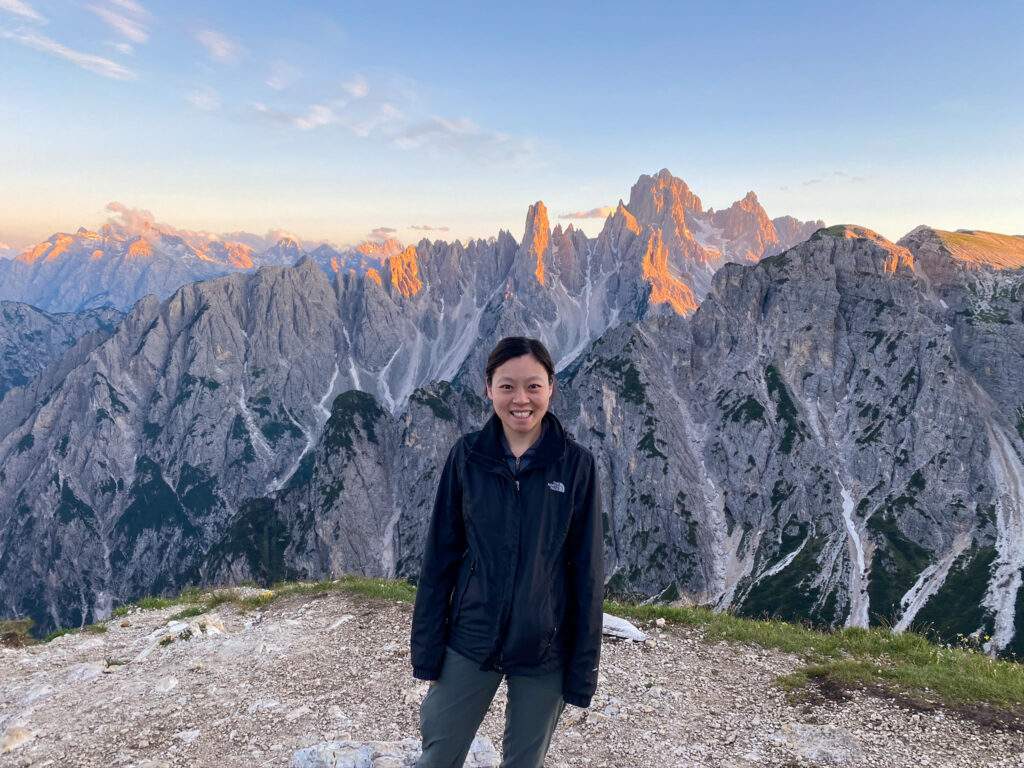“Wise is he who enjoys the show offered by the world.”
– Fernando Pessoa
Lisbon is a sentimental destination for me. In brief, Lisbon was my very first trip to Europe, back in 2014. It was my first international trip with my then-boyfriend, now-husband. Lisbon is where we decided I would move from Chicago to San Diego to live with him. We surprisingly had the joy of returning in 2020 for a work opportunity. Walking around Lisbon made my heart soar, just like when this city captured my heart back in 2014. Nevertheless, I felt compelled to write a travel guide to Lisbon, a city that holds so much sentimental value to me.
I wanted to make an essential travel guide to Lisbon to share my favorite spots and make your trip easier. I grouped most things by location so you can plan your days accordingly.
When Should You Go?
I visited in February and in September. Lisbon in February had mild temperatures ranging between 50°- 60°F. We consequently had light rain most days. The weather was therefore manageable with a lightweight waterproof jacket and an umbrella. There were 1-2 days of strong winds, which affected the opening of some historic sites. But, the best part of visiting in February was the off-season travel prices and crowds.
Lisbon in September was beautiful. The days were warm and sunny. We spent most of our time by the beaches in Cascais, but we were happy to come to Lisbon for a day trip here and there. It was busy in September. Furthermore, the high tourist season of July & August gets crowded.
Travel Guide to Lisbon Tips:
- The restaurant appetizers are not complimentary. When you sit at a restaurant or café the server usually brings small bites, like olives or some bread. If you nibble on them, the restaurant will charge you a very small fee. However, it’s only a couple of euros. If you do not want them, kindly set the dish aside. If you like olives, then try them! These are delicious!
- Portuguese is the official language. Some will find it offensive if you try to speak Spanish instead. Most of the locals we met spoke English well enough for us to manage, but you should have a few key phrases handy. We like using translation apps. Google Translate is free and easy to use. It was helpful for traveling and while we were living abroad.
- Portugal is famous for its tiles, copper, cork, olive oil, and canned sardines. I love the canned sardines. I even brought some home for my parents, and they are obsessed. The sardines are so good with Jasmine Rice.
Travel Guide to Getting Around Lisbon:
- Public transit is affordable and accessible. In effect, we got around by walking, riding the tram, and the metro.
- Using rideshare is an option, but be aware of peak traffic times. Traffic can get nuts, and then you’re stuck in a car wasting precious adventure time.
- We rented a car to drive around the Algarve, but I don’t recommend it in the city. The difficulty with parking alone is enough to stress me out.
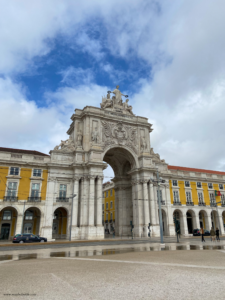
The Essential Travel Guide to Lisbon, Portugal
There is A LOT to see and do in Lisbon. Therefore, I wanted to make this essential travel guide to Lisbon easy for you to reference. So, I broke things down by neighborhood. Most of these neighborhoods are right next to and/or on top of each other. Lisbon is a hilly city. You’ll see what I mean. Personally, it is all within walking distance. Take that advice with a grain of salt. I am a big walker- my family and friends think I’m nuts for loving to walk so much. I also tried listing the sites within the neighborhoods in order of how I would walk around.
Baixa- The Historic Downtown
Firstly, let’s start in the heart of the historic city. After the historic and devastating earthquake in 1755, Baixa was rebuilt on a grid plan. The grid makes it easier for you to navigate at this time!
- Praça do Comércio- Waterside public plaza with a notable arch & statue. Being that, outdoor cafes and shopping venues surround the plaza. The square is a scenic spot with views of the Tagus River.
- Wines of Portugal- A wine-tasting venue right by the Praca do Comércio. You can stop inside to learn about and taste the wines throughout Portugal. One of our favorites is Vinho Verde! I know… You can buy Vinho Verde at Trader Joe’s, but I think it’s fun to try the local wines.
- Lisbon Cathedral – The oldest cathedral in Lisbon. It does indeed cost a small fee to enter. Visiting times vary as they still conduct services.
- Church of São Domingos – One of the busiest churches in Lisbon. The architecture is simple, and you can spot traces of the damage from earthquakes and fires.
- Praça dos Restauradores – Historic square that connects Rossio and Avenida da Liberdade. Nearby is Lisbon’s oldest hotel, Hotel Avenida Palace.
Where to Eat & Drink in Baixa
- Confeitaria Nacional – Additionally, you can enjoy sweets from the oldest bakery in Lisbon. We bought a few candies for our loved ones. You can also sit and enjoy some coffee and pastries. We tried their palmier and pastéis de nata. I have to admit, Confeitaria was our least favorite place for pastéis de nata. We have also tried their lattes, chocolate cake, and bolas de Berlin. There is a nice sitting area upstairs if you want to order from the menu. The staircase is my favorite part of the building.
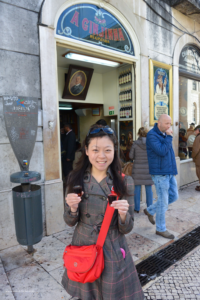
- A Ginjinha Bar – This spot is not much of a traditional bar, but a hole-in-the-wall shop. Ginjinha is a famous Lisbon alcoholic drink. It is a sweet liquor that tastes like sour cherry, cinnamon, sugar, and brandy served with a small ginja berry. You can buy a shot of this drink at Largo São Domingos 8 and sip on the drink right outside. A Ginjinha Bar is noticeable by the small crowd of people standing around it. I’m not a fan of the drink, but an acquaintance had me try this with dark chocolate, which was lovely. Ginjinha is pretty sweet, but the bitter dark chocolate cuts that sweetness.
- Café A Brasileira – An inexpensive coffee shop with delicious pastéis de nata. We stopped by for some strong coffee and a snack. It’s famous for being the favorite coffee shop of a Portuguese poet, Fernando Pessoa. There’s a statue of him sitting outside. You can’t miss it.
Chiado & Bairro Alto
- Elevador de Santa Justa- A 150-foot iron elevator connecting the lower and upper neighborhoods. If it reminds you of the Eiffel Tower, then you have a good eye. The Elevador was designed by the apprentice of Gustav Eiffel. For us, the ticket was too expensive for the short ride, so we walked up to the viewing platform. The viewing platform is free and worth the stop.
- Convento do Carmo- A museum that houses the convent ruins from the 1755 earthquake. A beautiful sight with the Gothic arches stretching towards the sky. We enjoyed some of the ruins from the outside view, but you can also pay a small fee to go inside.
- São Roque Church- The mural on the wood ceiling resembles a dome. The outside appearance may not be impressive, but it contains surprises inside.
- Solar do Vinho do Porto- I do not enjoy port, but my FoMO carried me in anyways. I listened, learned, and sampled. I even took a break in one of their enticing lounge chairs. I still do not prefer port, but it was fun to sip and lounge in this dark and classic atmosphere.
- Miradouro de São Pedro de Alcântara – Enjoy the high city views. There are vendors selling snacks and drinks while others play live music. Above all, the terrace is a popular spot for people to relax and enjoy the city. I love this beautiful spot with gardens and fountains.
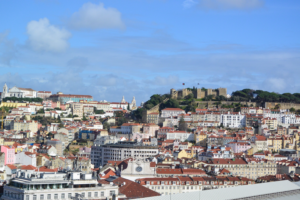
- Elevador da Glória- We did indeed take this funicular ride up a very steep neighborhood block. It wasn’t on our original plans, but once we saw it, we could not resist. I loved the wooden interior and the graffiti art along the city walls.
- Bars- Barrio Alto has lively nightlife. These narrow streets flood with people hanging out throughout the night.
Alfama
- Wander the Streets- Roam around the winding and cobbled streets of Alfama. The architecture is beautiful. Get a little lost. Stop at random local spots for refreshing drinks, coffee, and snacks.
- Mercado de Santa Clara- A fun and wide-ranging flea market near Alfama. The market is open Tuesdays and Saturdays. We found it a particularly great place to browse and buy souvenirs. We purchased some cork items and beautiful reclaimed tiles. You will have to do a little digging to find some real treasures.
- Praça Júlio de Castilho- I’m so in love with this garden and terrace. There were so many vibrant flowers when we were here in September. It’s a popular spot, and there are usually crowds.
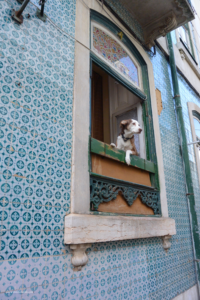
- Castelo de São Jorge- The Moors built the Castelo in the 11th century. The Castelo fell to ruins in the 1755 earthquake and was rebuilt in the 1960s. At this time, it’s a big museum, garden, and archeological site. Several spectacular peacocks live on the grounds.
- Miradouro de São Jorge- A terrace at the Castelo de São Jorge. Being that, it was a very popular picture spot.
- Listen to Fado- Alfama is famous for this music genre, notable for its expressive nature. There are a lot of emotions in these songs. We came by in the evening to walk around and find a place for dinner and Fado. It was a lovely way to spend an evening.
Cais do Sodre
This neighborhood used to be the red-light district. Nowadays, it is filled with bars and clubs, but it was pretty quiet during the day. We haven’t spent much time here as there isn’t much to see during the day, and I don’t party like I’m in my early 20s anymore.
- Bars & Clubs- The area is recognized for hyped nightlife when all the clubs and bars open.
- Pink Street- A known Instagram spot. The pink-painted street also has colorful hanging umbrellas.
- Mercado da Ribeira/ Time Out Market Lisbon- This food hall and music venue is a fun spot. It’s funny to see something so modern in historic Lisbon. The market had a lot of food stands with plenty of options. On the other side of the building is the local Farmers’ Market. It was fun checking out the market to see what was in season and the daily catch. It helped me decide what I wanted to eat during my visit! However, it can get cramped with tourists and their large suitcases.
- Elevador da Bica- A 19th-century cable railway. Two small cars ride up & down a quaint street with a sharp incline. The trip is a very short distance and it’s not free. Even if you don’t ride it, I thought it was pretty fun to watch the cable work.
Travel Guide to More Fun Places in Lisbon…
- National Tile Museum/ Museu Nacional do Azulejo- I wasn’t sure where to place the Tile Museum on this essential travel guide. It’s located northeast of Alfama, and it took us about 30 minutes to walk there from Castelo de S Jorge. The building is the historic Convento de Madre de Deus. It is now a museum and home to a stunning collection of Portuguese tiles. Do not miss the cloisters. Be sure to go upstairs to see a tiled panorama of Lisbon before the big earthquake in 1755.
- A Vida Portuguesa- a darling and busy souvenir and home goods store. It is a one-stop shop to get all your shopping done at once. The last time I visited, they were partnering with local artists too! There are several locations throughout the city. My husband loves souvenir shopping, and this store was a n opportunity to purchase items not in the typical souvenir traps.
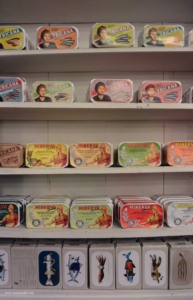
A Travel Guide to Lisbon: Nearby Points of Interest
This essential travel guide to Lisbon has plenty of places to keep you busy in the city. Yet, there are more fun and fascinating nearby places you do not want to skip.
Belém
This area is about 3 miles west of downtown Lisbon. Belém is where they would send off voyagers during the Age of Discovery. Somehow, the buildings survived the 1755 earthquake. Belém is easy to get to from Lisbon via the train or trolley. I would probably walk the distance, but Hubs said “hard pass” on that idea.
- Pastéis de Belém – The birthplace of the famous pastéis de nata. Hands down, this has our favorite pastéis de nata in Portugal. We love it so much, we’ve returned many times. We went early and later in the day to avoid the crowds, which I strongly recommend. Try some of the savory items on their menu, including the duck and spinach pie and the chicken pie. The pies were perfectly portioned to enjoy two servings. The puff pastry was flaky and delicious. My tummy is growling at the thought of them now.
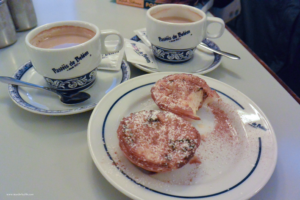
- Museu Nacional dos Coches/ National Coach Museum – The old palace riding school is at this time a museum of the collection of royal coaches. It is worth the admission. Each carriage is a masterpiece. There was a beautiful mixture of simple and ornate designs. We were here for about 2 hours.
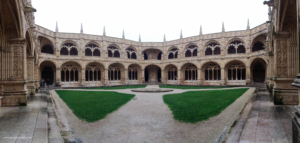
- Monasterio de los Jerónimos – A famous 16th-century white limestone monastery. The Monasterio is an iconic symbol of visiting Lisbon. We were awed by the cloisters and enjoyed the exhibits. We were here for about 2 hours. The details are so complex and astounding.
- Igreja Santa Maria de Belem- A free Catholic church that is part of the Monasterio. Go inside to see beautiful architecture, intricate stained-glass windows, and the tomb of the famous explorer Vasco de Gama.
- Praça do Império / Jardim da Praça do Império- A green space with fountains. It makes a beautiful picture with the monastery in the background. The view is especially beautiful in the early evening when the fountain and lights are on.
- Garden Vasco de Gama- A peaceful park and garden. The plentiful trees and soft grass make it a perfect spot in the hotter months.
- Waterfront Promenade- The promenade had significant updates between my first visit and 2020. Take a walk and enjoy the views of the Tagus.
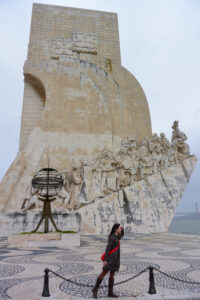
- Sculptures- There are several sculptures if you walk along the promenade. We really liked the Monument Gago Coutinho e Sacadura Cabral.
- Padrão dos Descobrimentos – The Monument to the Discoveries honors the death of Prince Henry the Navigator. Furthermore, nearby is a marble map of the world on the pavement known as the Rose Compass.
- Torre de Belém / Belém Tower – The white tower protecting the harbor is a National Monument and a UNESCO World Heritage Site. The Torre was the greeting and farewell sight for sailors. The inside was pretty empty, but the tower provided broad views of the Tagus. I recommend checking the hours of operation, as this place closed pretty early. The Torre de Belém is a beautiful spot for sunset.
Sintra
Sintra is a small town near Lisbon, and it was the summer retreat for Portuguese Royalty. Today, Sintra is the perfect day trip from Lisbon. It took us about 40 minutes by train from the Rossio Station.
- Parque Nacional Da Pena- This beautiful green forest took me by surprise. We hiked the trails to/from Palácio da Pena and Castelo dos Mouros. The lush moss on the old walls was beautiful. The area was pretty isolated. Wear comfortable shoes if you go. The walk is a bit of a hike.
- Castelo dos Mouros – The Moorish Castle was a 15-minute hike from Pena Palace. In February, it was cold, hailing, and very windy. There were very few people around, probably due to the weather. The staircases to climb to the top did not have railings, so be careful, especially if the weather is not ideal. Notice how low and narrow the openings and arches are when walking around. Watch your head. We saw a gentleman knock his head really hard, and it was so hard that we heard it. Once there, enjoy the views. It is a pretty cool experience.
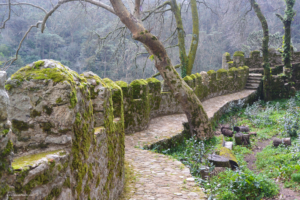
- Palácio da Pena – Tickets are required. The architecture is a fun mixture of many styles and bright colors. The palace is busy in July and August.
- Poço Iniciático/ Initiation Well- You have likely seen pictures of this famous ceremonial well. It’s notorious for its spiral staircase. I have never been, but I have seen plenty of pictures of it around Sintra and on Instagram. There is an admission fee to visit. When we were in the area, a local told us it was harder to get to and that we would need to take our car or a rideshare to get there. A friend told me it gets crowded, so weekdays are best.
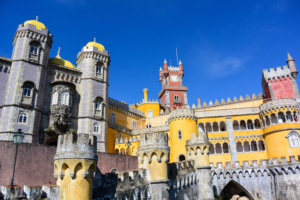
Obrigada!
I know… that is a lot of information to take in. I hope you find this essential travel guide to Lisbon helpful. There is plenty to see and do while you’re here. Use this guide to maximize your time and soak in the joy of traveling around this historic city. Most importantly, take the time to enjoy Lisbon. Feel free to share your stories in the comments below. Enjoy!
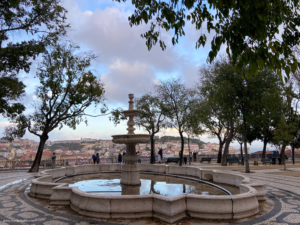
Like What You’re Reading?
Here are some other posts that may interest you:
6 Must-Sees in Le Havre, France
Le Havre is not a typical city one usually thinks of when planning a trip to France. However, it should be on your radar. Le Havre is a historically paramount port city. Here are 6 things you do not want to miss when you visit Le Havre, France.
5 Breathtaking Sights You Don’t Want to Miss in Étretat, France
A France road trip along Normandy should be on everybody’s bucket list. On your road trip, you need to include a stop in Étretat. These are some of the most breathtaking sights you don’t want to miss on this trip.
A Handy Guide to Oktoberfest
Are you planning on going to Oktoberfest? Here is a handy guide to enjoying Oktoberfest. If you are visiting Oktoberfest, it would be a shame not to take the opportunity to experience Munich as well. Included is how to spend the day after Oktoberfest in Munich.
6 Neighborhoods You Have to Visit in Berlin
These are the 6 neighborhoods you have to visit in Berlin. With so much to see and do in this fun city, these are the neighborhoods you don’t want to miss on your trip.
London Eats and Treats
There are so many things to do in London, including eating all the food. Here’s a growing list of some London Eats and Treats!
London
How funny is it that my first visit to London was driven by attending an NFL game? We took a weekend trip to London, which is a quick train ride from Brussels. London is a big city and requires much more time to soak it all in.
